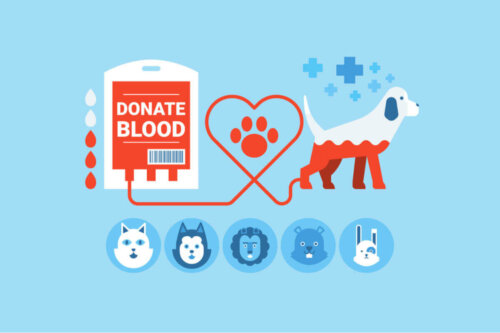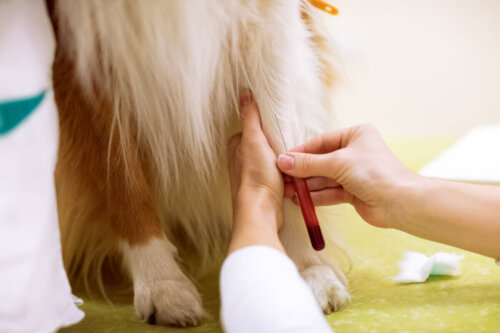Voluntary Animal Blood Donation Campaigns

There has been growing interest in transfusions for veterinary medicine recently, and, as a result, many countries around the world have created blood banks for animal blood donation. This has also led to increasing development in the area of treating critically ill animals with donated blood.
Since all blood must come from healthy pets, the need to find new donors is always pressing. That’s why it’s so important to inform owners about their options for helping.
Transfusions in veterinary medicine throughout history
The use of blood transfusions in animals isn’t exactly new. It’s been going on for a long time and, in fact, one could consider it to be the origin of transfusions in human medicine.
In 1665, Richard Lower, an English physician, carried out a transfusion between two dogs. From then on, there were more experiments like this. In fact, it was only a matter of time before there were similar experiments in humans.
Initially, blood transfusions were drawn directly from the donor using an anticoagulant. Then, the blood was administered to the recipient a few hours after the donation.
However, given an increase in demand and limited supply, we’re working to make better use of this resource. This is why there’s a tendency to administer only the necessary blood components. For example, now we can administer only the red blood cells or plasma.

Selecting pets for animal blood donation
Similarly to humans, not all animals are valid candidates for blood donation. Here are some of the considerations to take into account before recommending your pet as a donor.
Animal blood donation: Donor dogs
Canine donors need to meet certain characteristics, such as:
- Being in good health.
- Weighing at least 55 pounds so that blood can be stored in standard human collection bags.
- Many canine donation programs set an age limit of between one and eight years old.
- Having all the proper vaccines according to their age and the vaccination schedule in your country.
- Not undergoing any medical treatment at the time of donation, with the exception of preventative medication against parasites.
It’s best to use dogs that are able to stay still on their own during the extraction procedure. However, if necessary, you can use light sedation, although this could have adverse consequences.
Any dog that has previously received a transfusion may have developed antibodies against different blood types than their own. Therefore, animals that have received transfusions aren’t suitable donors.
Tests prior to donating blood
It’s necessary to:
- Determine the blood type. It’s most common to use “dog erythrocyte antigen” (DEA) to identify the type.
- Perform general blood work and a physical examination to verify the dog’s health.
Some infectious diseases have the potential to be transmitted via blood transfusion. These can be from serious infections, such as leishmaniasis or brucellosis. Therefore, ensuring the absence of these microorganisms in potential donors is important.
Also, in countries like the United Kingdom, dogs that have traveled abroad are excluded as donors. This greatly reduces the need for extensive testing for infectious diseases.
Animal blood donation: Donor cats
The requirements for cats are very similar to those of dogs, with some differences inherent to the species. For example, concerning weight, it’s enough that the cat is heavier than 9 pounds.
In addition to the importance of the blood type, there’s also concern about possible infections. For example, a donation center will conduct tests to rule out feline leukemia or cat immunodeficiency, among other things.
Given the need to sedate donors and the strict requirements about disease prevention, it’s difficult to create a large pool of feline donors.
The most significant veterinary centers may consider housing a group of disease-free donor cats. Then, after a while, these cats are relocated as pets.

Animal blood donation: Did you think this was just for humans?
Experts say that there’s a widespread lack of awareness regarding animal blood donation. Alternatively, it could be a lack of access to information, which is possible, but this seems difficult in the age of the internet.
Any voluntary donation plans are based on the altruism of the pet owner. However, it’s true that the dog is usually rewarded with food, trinkets, or toys.
However, it’s important to spread the word about animal blood donation because you might never know when your faithful companion may be the one who needs help from another animal.
All cited sources were thoroughly reviewed by our team to ensure their quality, reliability, currency, and validity. The bibliography of this article was considered reliable and of academic or scientific accuracy.
- King L, Boag A. BSAVA manual of canine and feline emergency and critical care. 2nd ed.
